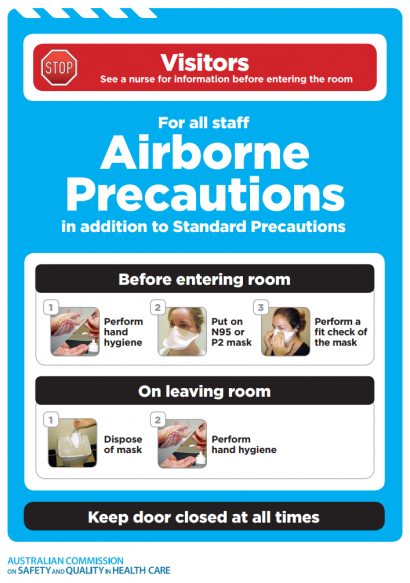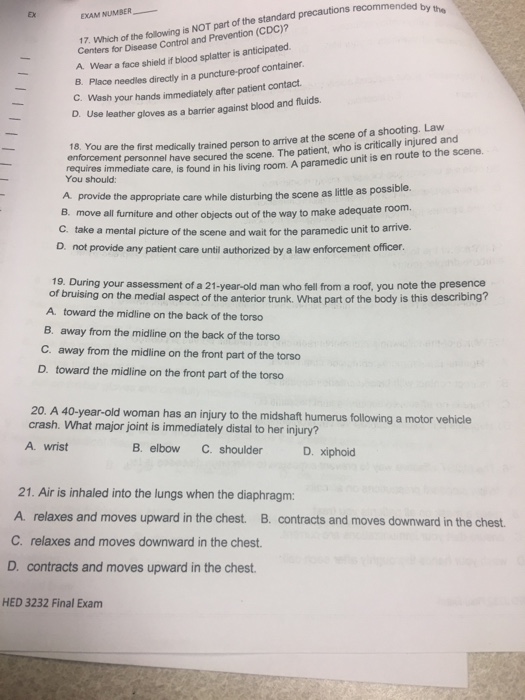Which of the Following Is a Part of Contact Precautions
No studies have directly compared the efficacy of Standard Precautions alone versus Standard Precautions and Contact Precautions with or without ASC for control of MDROs. Neutropenic precautions are used when a patient has a low number of neutrophils in their immune system making them immunocompromised.

Standard And Transmission Based Precautions And Signage Australian Commission On Safety And Quality In Health Care
These Transmission Based Precautions are in addition to Standard Precautions as a part of a basic infection prevention and control program.

. For a patient on contact precautions any equipment used should be dedicated to that patient during the hospitalization. Indirect contact occurs when health care personnel are in the. They are used anytime there is a known potential for spreading.
Hand hygiene before and after all patient contact the use of personal protective equipment which may include gloves impermeable gowns plastic aprons masks face shields and eye protection. Which of the following is a part of Contact Precautions. Neutropenic precautions may be used for patients that have AIDS or who are on immunosuppressants.
3 The different types of TBP are applied based on what is known or suspected about a patients infection. Full compliance with contact isolation precautions was significantly higher during the week as compared to the weekend 12 vs. After contact precautions for ESBL-producing E.
The spread of germs can occur when touching an infected person and their dirty items such as clothing and surfaces. Some reports mention the use of one or both sets of precautions as part of successful MDRO control efforts. Neutropenic and Radiation Precautions.
Neutropenic precautions are comparable to contact precautions. Contact Precautions are used when patients have an infection that can be spread by contact with the patients skin including mucous membranes feces vomit urine wound drainage or other body fluids. Perform a risk assessment based on patients communicability or risk of transmitting infection to others and to healthcare workers.
You may also need contact precautions if you have an ostomy or a bag that collects your urine or bowel movements. Transmission-based precautions TBP for contact- droplet- and airborne-transmissible diseases augment SP with additional controls to interrupt the routes of transmission that may not be completely interrupted using SP alone. Aureus Airborne Precautions plus contact Skin or Wound Infection Abscess or draining wound that cannot be covered Staphylococcus aureus group A streptococcus Contact Precautions Add Droplet for the first 24 hours.
However the precautions were not the primary focus of the study. Contact precautions when used with standard precautions are designed to reduce the risk of transmission of microorganisms by direct andor indirect contact. For communicable disease exposure PPE is specialized clothing or equipment used to prevent contact with hazardous substances.
In ambulatory settings place patients requiring contact precautions in an exam room or cubicle as soon as possible. Its use is an integral part of infection control and prevention measures that protect workers from exposure to blood body fluids and other potentially infectious materials. Which of the following interventions is not a part of airborne precautions.
All re-usable items taken into an exam room or home should be cleaned and disinfected before removed. Standard Precautions involve hand hygiene. Proper washing with an anti-microbial soap will kill bacteria that are present on the surface of the skin including normal residents of the skin such as Staphylococcus aureus and bacteria in the genus Streptococcus.
You may need contact precautions if you have diarrhea draining wounds a rash or lice. These signs aim to help healthcare workers remember when certain precautions are necessary to help prevent infections and save lives. At least one supply item for contact isolation precautions was observed as inadequate at hospital A in 83 of 184 45.
Demonstrated reduction in colonization and infection after the adoption of infection control measures based on the identification of nasal or rectal MRSA carriage by swabs contact precautions patient. These are examples of coming into direct contact with the patient. Disposable items should be discarded at point of use.
Coli were discontinued at the 2 hospitals in this study transmissions occurred in 26 of contact patients at UHB and in 88 of contact patients at FPH. Use personal protective equipment PPE appropriately including gloves and gown. Healthcare personnel caring for patients wear a gown and gloves for all interactions that may involve contact with the patient or potentially contaminated areas in the patients environment.
Your Answer Patients are isolated in private rooms or cohorted. Strict hand hygiene gloves gowns and contact precautions in a private room are recommended for the duration of diarrhea in patients with CDI. Microorganisms by direct or indirect contact Direct contact skin-to-skin contact physical transfer turning patients bathing patients other patient care activities Indirect contact Contaminated objects Hands Equipment Clothing- potential exists for contaminated clothing to transfer infectious agents to successive patients.
Wear gloves and gown when in contact with the individual surfaces or objects within hisher environment. PPE such as gowns gloves masks and goggles provide. The door to the patients room may be kept open if the patient is on droplet precautions.
Feedback Patients on Contact Precautions should be isolated in private rooms or cohorted. Contact Precautions The use of a 10 sodium hypochlorite solution bleach mixed fresh daily one part household chlorine bleach mixed with nine parts tap water has been associated with a reduction in CDI in some settings. Standard precautions consist of the following practices.
Airborne plus Contact precautions Respiratory Infections Coughfeverupper lobe infiltrate Tb Respiratory Viruses S. Wear a gown and gloves for all interactions that may involve contact with the patient or the patients environment. Contact isolation compliance between weekdays and weekends was also compared.
Use of gloves gown mask eye protection or face shield depending on the anticipated exposure. A fundamental contact precaution is handwashing. Transmissions were associated with duration of hospitalization in the same room as an index patient.

Isolation Precautions Mnemonics Cheat Sheet Nursing Mnemonics Nursing School Survival Nursing School

Nursing Mnemonics Nclex Nursing School Tips
Standard And Transmission Based Precautions And Signage Australian Commission On Safety And Quality In Health Care

Printable Universal Precautions Sign Infection Control Nursing Dental Infection Community Health Nursing

Infection Prevention And Control Physiopedia

A Roundup Of Companies Pivoting To Provide Masks And Ppe And Therapy For Health Care Workers And In 2021 Health Care Care Worker Medical Care

Standard Precautions In Health Care

Pin On Doterra Product Information

A List Of Transmission Based Precautions Recommended For Common Pathogens Nursing School Survival Medical Surgical Nursing Nursing School Studying

Solved Which Of The Following Is Not Part Of The Standard Chegg Com

Nurses Ebola Education Module And Safety Poster Health And Safety Poster Occupational Health And Safety Infection Control Nursing
![]()
Standard And Transmission Based Precautions And Signage Australian Commission On Safety And Quality In Health Care
![]()
Standard And Transmission Based Precautions And Signage Australian Commission On Safety And Quality In Health Care

Comments
Post a Comment